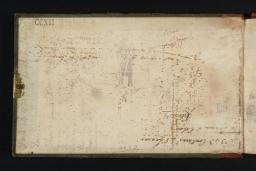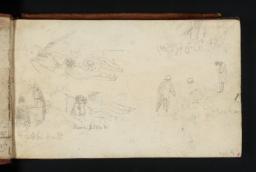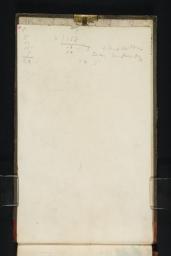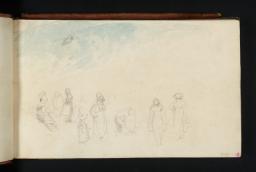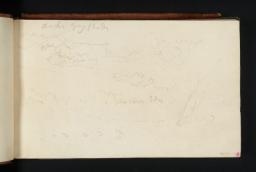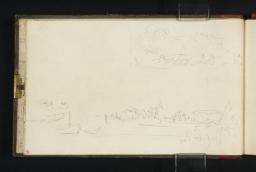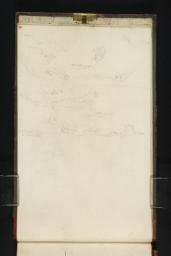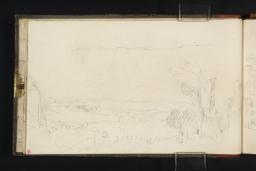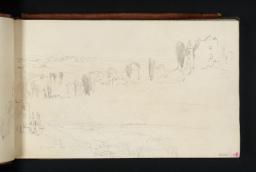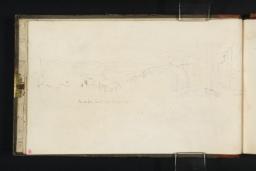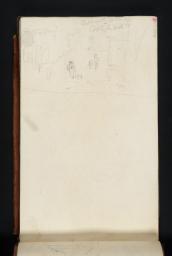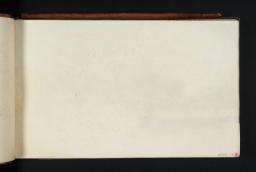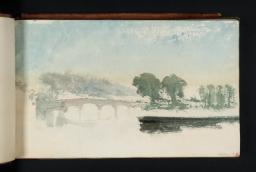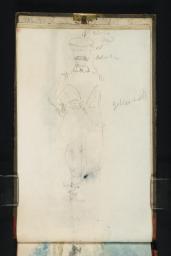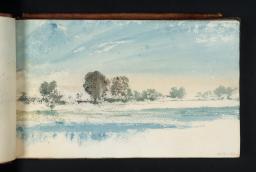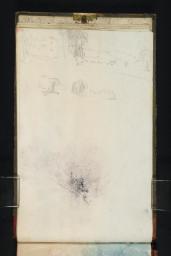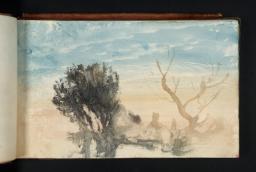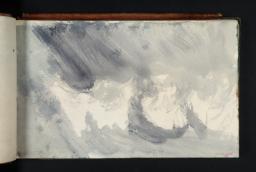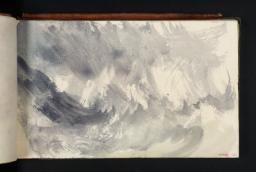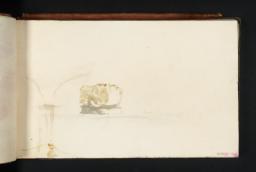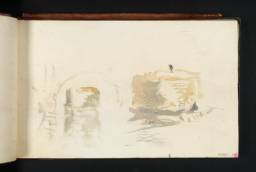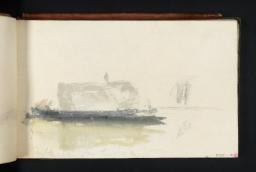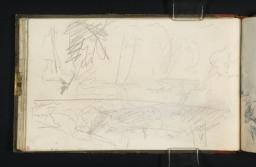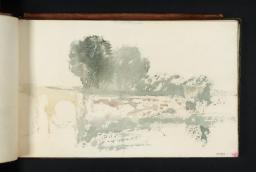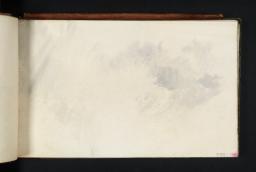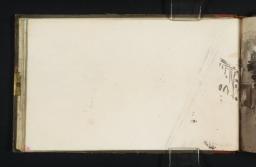J.M.W. Turner
>
1819-29 Italy and after
>
Thames, London and South of England 1821 ...
>
Thames Sketchbook
Turner Bequest CCXII 1–91
Sketchbook, bound in boards, covered in grey paper quarter-bound over brown leather spine; one brass clasp, now missing
91 leaves and paste-downs of white wove paper, page size 114 x 188 mm; watermark ‘Allee | 1819’
Made by William Allee of Hurstbourne Prior Mill, Hampshire
Inscribed by Turner on a label on the spine in ink ‘Thames’ (now lost)
Numbered 343 as part of the Turner Schedule in 1854 and endorsed by the Executors of the Turner Bequest, inside front cover (D40969)
Inscribed in pencil ‘CCXII’ on back cover, bottom centre, upside down
Stamped in black ‘CCXII’ on front cover, top right
91 leaves and paste-downs of white wove paper, page size 114 x 188 mm; watermark ‘Allee | 1819’
Made by William Allee of Hurstbourne Prior Mill, Hampshire
Inscribed by Turner on a label on the spine in ink ‘Thames’ (now lost)
Numbered 343 as part of the Turner Schedule in 1854 and endorsed by the Executors of the Turner Bequest, inside front cover (D40969)
Inscribed in pencil ‘CCXII’ on back cover, bottom centre, upside down
Stamped in black ‘CCXII’ on front cover, top right
Accepted by the nation as part of the Turner Bequest 1856
Exhibition history
1974
Turner 1775–1851, Royal Academy, London, November 1974–March 1975 (262).
1980
Turner at the Bankside Gallery: Drawings & Water-colours of British River Scenes from the British Museum, Bankside Gallery, London, November–December 1980 (66, exhibited pages not specified).
1988
Summer Miscellany: Watercolours from the Turner Bequest, Tate Gallery, London, July–October 1988 (no catalogue).
1989
Summer Miscellany: Watercolours from the Turner Bequest, Tate Gallery, London, July–September 1989 (no catalogue).
1997
Turner’s Watercolour Explorations 1810–1842, Tate Gallery, London, February–June 1997, Southampton City Art Gallery, June–September 1997 (48).
2000
Pure as Italian Air: Turner and Claude Lorrain, Clore Gallery, Tate Britain, London, November 2000–April 2001 (no catalogue).
2002
Turner et le Lorrain, Musée des beaux-arts, Nancy, December 2002–March 2003 (58).
2006
Turner and the Natural World, Clore Gallery, Tate Britain, London, April–October 2006 (no catalogue).
References
1909
A.J. Finberg, A Complete Inventory of the Drawings of the Turner Bequest, London 1909, vol.II, pp.646–7, CCXII 1–92. as c.1825.
1969
John Gage, Colour in Turner: Poetry and Truth, London 1969, p.58. as c.1825.
1974
Martin Butlin, Andrew Wilton and John Gage, Turner 1775–1851, exhibition catalogue, Royal Academy, London 1974, p.97 under no.262.
1975
Gerald Wilkinson, Turner’s Colour Sketches 1820–34, London 1975, p.30.
1980
Michael Spender and Malcolm Fry, Turner at the Bankside Gallery: Catalogue of an Exhibition of Drawings & Water-colours of British River Scenes from the British Museum, exhibition catalogue, Bankside Gallery, London 1980, p.143 no.66. as c.1825.
1993
David Hill, Turner on the Thames: River Journeys in the Year 1805, New Haven and London 1993, pp.152–3.
1997
Eric Shanes, Turner’s Watercolour Explorations 1810–1842, exhibition catalogue, Tate Gallery, London 1997, p.65 under no.48.
1999
Peter Bower, Turner’s Later Papers: A Study of the Manufacture, Selection and Use of his Drawing Papers 1820–1851, exhibition catalogue, Tate Gallery, London 1999, p.40 under no.12.
2014
Ian Warrell, Turner’s Sketchbooks, London 2014, p.136, as 1825.
The identified pencil drawings in this sketchbook mainly comprise familiar vistas over the Thames Valley from Richmond Hill, and associated river scenes in the Richmond and Isleworth area. For the numerous sketches from the hill at both ends of the book, which would have informed two subsequent watercolours, see under folio 5 verso (D18603).
Finberg thought that the sketchbook was in use around 1825;1 later scholars have concurred, and the date is retained here for lack of any internal evidence to the contrary. Indeed, scribbled but evidently significant notes on folios 90 verso and 91 verso (D18703, D40972) are emphatically dated ‘Richmond 1825’. Unfortunately the last digit of the full date written twice on folio 47 recto (D18652) is difficult to make out, and both versions may be read as ‘June 25 1823’ or ‘1825’. That the weekdays and dates of the months in at least the first few tabulated entries of a scheme of payments noted inside the front cover (D40969) correspond to those in 1825 is another pointer to that year; see also the related calculations on folio 1 verso (D18596).
It has been suggested that drawings at the front and back were made on Turner’s tour of the Low Countries in August 1825,2 when he mainly used the Holland and Holland, Meuse and Cologne sketchbooks (Tate; Turner Bequest CCXIV, CCXV). See the sketches, mainly of figures and shipping (some of which could equally have been observed along the Thames, and some of which share pages with identified Thames subjects), inside the front cover and on folios 1 recto, 2 recto, 3 recto and verso and 5 recto (D40969, D18595, D18597–D18599, D18602) and then on folios 87 recto, 89 recto and verso, 90 verso, 91 recto and verso and inside the back cover (D18697, D18700, D18701, D18703, D18704, D40972, D40973).
As Ian Warrell has observed, 1825 was the last full summer the artist could have spent at Sandycombe Lodge,3 his self-designed country villa at Twickenham (see the Introduction to the ‘Sandycombe Lodge c.1808–1812’ section of the present catalogue). Despite his longstanding attachment to the area, Turner sold the house for practical reasons on 19 June 1826,4 having always retained his central London residence with its studio and gallery. Much of the first half of the book is taken up with twenty-five full-page watercolour studies which appear to be Thames Valley subjects in spirit if not in their precise topography, on the rectos of folios 9–31, 33 and 34 (D18609, D18611, D18613–D18618, D18620–D18631, D18633–D18635, D18637, D18638). D18623 is continued a little way onto folio 19 verso opposite (D40970), while D18633 is superimposed on a pencil sketch, the other half of which, on folio 28 verso (D18632), was left uncoloured; this double-page drawing may have preceded the watercolour sequence and be unrelated to it. Watercolour was also used more sparingly at the beginning and end of the book, on folio 2 recto (D19597) and, apparently, on folio 91 recto (D18704).
David Hill has described some of the colour subjects as composed of ‘evanescent washes, almost Chinese in style and ethereal’, suggesting that they are ‘in many respects a way of not engaging with reality, of transcending it, of letting go, of being able to say goodbye’5 to Turner’s time by the rural river. More prosaically, Gerald Wilkinson thought most of them, with their ‘direct, broad brushwork’, ‘unexciting – but nice’.6 Eric Shanes has considered their technical means, as showing ‘the degree to which Turner could explore remembered or imagined landscapes in his sketchbooks wholly in terms of colour’ through ‘extremely vivacious watercolour sketches of river scenery. In many of them Turner took advantage of the slight resistance of the paper to certain pigments. Such a speckling of the colours can be seen to great advantage in the page on display, for it lends enormous sparkle to the scene depicted.’ Shanes has also observed that as with ‘many of Turner’s sketchbooks in which he worked up colour sketches and studies, the absence of any pigment or staining on the opposite pages shows that he took a patient approach to making such works, waiting for each page to dry before starting the next one’.7 With regard to these perhaps deceptively spontaneous compositions, John Gage has noted ‘Turner’s need to be specific, his care for controlled expression’, such that in effect ‘the element of improvisation is minimal’.8
There are studies of ceremonial barges on folios 4 recto, 71 verso and apparently 72 recto (D18600, D18679, D18680). The later two include river landscapes typical of the pencil sketches scattered through the book apart from the Richmond Hill views; some are identified as being around Isleworth and the adjacent Syon Park and Kew, and others are no doubt along nearby reaches of the Thames at Richmond and Twickenham. See folios 3 verso, 7 recto and verso, 10 verso, 16 verso, 46 verso, 47 recto, 49 verso, 69 verso–70 recto, 75 verso and 91 verso (D18599, D18606, D18607, D18612, D18619, D18651, D18652, D18655, D18676–D18677, D18684, D40972). Otherwise, there are typically miscellaneous studies of sunsets, a working barge, a hussar officer (perhaps sketched strolling on Richmond Hill), the sails of a Thames barge, and shipping near St Paul’s Cathedral (folios 4 verso, 5 recto, 9 verso, 32 recto, 81 verso; D18601, D18602, D18610, D18636, D18691). Meanwhile, Turner’s instinctive tendency to idealise or classicise his Thames subjects is seen in his thumbnail study for a river or seaport composition on folio 47 verso (D40971); see also folio 20 recto (D18623).
Finberg recorded a label (since lost) ‘on back–“Thames.”’9 Like those which survive on other sketchbooks, this was presumably in ink on a white wove paper label pasted onto the spine. David Hill initially suggested that Turner devised his sequence of numbered and annotated labels during a general review of the sketchbooks in about 1821 or 1822,10 later revising this to the second half of 1824 on the dating evidence of some of the relevant books.11 Ian Warrell has subsequently reasoned that the process began in 1823, ending in the summer of 1824,12 which may cast a little doubt on the conventional dating of the present book; perhaps, since the label did not apparently include a number, Turner continued the practice in a modified form. Finberg also noted John Ruskin’s comments on a separate wrapper: ‘343. Slight experiments in colour on white paper.’13
See Patrick Youngblood, ‘The Painter as Architect: Turner and Sandycombe Lodge’, Turner Studies, vol.2, no.1, Summer 1982, p.33.
See David Hill, ‘The Landscape of Imagination and the Sense of Place: Turner’s Sketching Practice’ in Maurice Guillaud, Nicholas Alfrey, Andrew Wilton and others, Turner en France, exhibition catalogue, Centre Culturel du Marais, Paris 1981, pp.143, 147 note 34.
Technical notes
The pages are in good condition; see Eric Shanes’s comments above for the properties of the paper and how it suited Turner’s extensive use of watercolour. The female brass clasp on the front cover survives, but only the staples originally anchoring the corresponding back clasp remain. There is a leather pencil holder along the top edge of the back cover, set between the board and the paste-down.
The paper is by William Allee of Hurstbourne Prior Mill, Hampshire.14 Bower categorises the book with a large number of similar, mass-produced notebooks in the Turner Bequest, subdividing them into six ‘Types’ in terms of their bindings. This one is of ‘Type 4’: ‘Grey (originally bluer than seen here) paper-covered boards, brown leather spine, brass clasp, leather pencil holder, approximately 90 leaves (variable)’;15 other ‘Type 4’ sketchbooks made up of Allee paper also watermarked 1819 are Norfolk, Suffolk and Essex, Holland, Meuse and Cologne, and Brighton, Newhaven and Cowdray (Tate; Turner Bequest CCIX, CCXV, CCXLVI).16
What Finberg recorded as the last page of the sketchbook, ‘92. Thames, from Richmond Terrace, and other slight sketches’,17 has long been recorded as missing; however, although he did not list the drawing on the back of folio 91 recto (D18704), the subjects there (D40972) could be those he described for the putative page ‘92’, so it is possible that the latter number was simply a mistake for ‘91a’.
Matthew Imms
December 2014
-
Joseph Mallord William TurnerThames SketchbookD40969
-
Joseph Mallord William TurnerThames SketchbookD18595
-
Joseph Mallord William TurnerThames SketchbookD18596
-
-
Joseph Mallord William TurnerThames SketchbookD18598
-
Joseph Mallord William TurnerThames SketchbookD18599
-
Joseph Mallord William TurnerThames SketchbookD18600
-
-
Joseph Mallord William TurnerThames SketchbookD18602
-
-
-
-
Joseph Mallord William TurnerThames SketchbookD18606
-
Joseph Mallord William TurnerThames SketchbookD18607
-
-
-
-
-
Joseph Mallord William TurnerThames SketchbookD18612
-
-
-
-
-
Joseph Mallord William TurnerThames SketchbookD18617
-
-
Joseph Mallord William TurnerThames SketchbookD18619
-
-
-
-
Joseph Mallord William TurnerThames SketchbookD40970
How to cite
Matthew Imms, ‘Thames Sketchbook c.1825’, sketchbook, December 2014, in David Blayney Brown (ed.), J.M.W. Turner: Sketchbooks, Drawings and Watercolours, Tate Research Publication, April 2015, https://www

